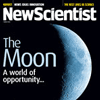 |
||
| Monday / 3 April 2006 | ||
Importance
of Moon, Lunar South Pole Featured in Popular Magazine.
The April edition of New
Scientist magazine
focuses on the Moon, with a waxing crescent gracing its cover and
10 pages of articles and graphics featuring Luna. "The
Moon is one of the best pieces of real estate for scientific research
in the solar system," writes David Chandler, also of the Boston
Globe.
He covers nearly all aspects of lunar benefits, even explaining how
astronomy from the Moon holds benefits over space telescopes, namely
in the fields of RFI-free observation and optical interferometry.
UC Berkeley Antarctica astronomer Yuki Takahashi is cited saying
there is an unobserved low-frequency radio spectrum to be explored
from the Moon -- "the last unexplored window in astronomy."
Chandler says some NASA scientists are already developing far-side
radio interferometry
missions. His article also
explains
the
brief history of the NASA Vision for Space
Exploration.
"Suddenly,
years
of (lunar)
plans, designs and concepts that had seemed doomed became part of
the world's biggest space program," he writes. Chandler also covers
the radiation hazard and how the International Space
Station will be factored into the Moon plans. He doesn't forget the
beauty of the Moon, writing, "The view from Malapert Mountain is
guaranteed to take your breath away." A one-page 'Where to Site a
Lunar Laboratory' graphic focuses on the South Pole, specifically
the Aitken Basin, Malapert and Shackleton Crater. New Scientist says
the ~5-km-tall Malapert is in constant view of Earth for perfect
radio
communications
and receives sunlight 90% of the time for power.
|
||
